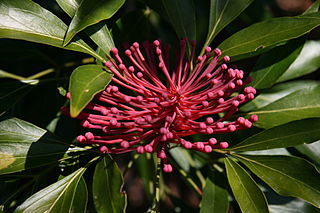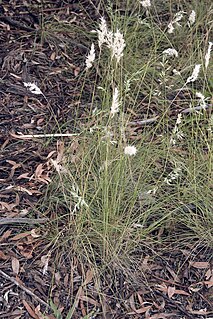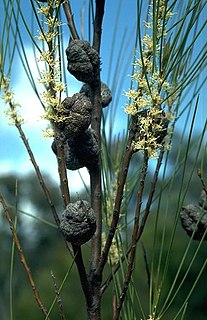
Waratah (Telopea) is an Australian-endemic genus of five species of large shrubs or small trees, native to the southeastern parts of Australia. The best-known species in this genus is Telopea speciosissima, which has bright red flowers and is the NSW state emblem. The Waratah is a member of the family Proteaceae, flowering plants distributed in the Southern Hemisphere. The key diagnostic feature of Proteaceae is the inflorescence, which is often very large, brightly coloured and showy, consisting of many small flowers densely packed into a compact head or spike. Species of waratah boast such inflorescences ranging from 6–15 cm in diameter with a basal ring of coloured bracts. The leaves are spirally arranged, 10–20 cm long and 2–3 cm broad with entire or serrated margins. The name waratah comes from the Eora Aboriginal people, the pre-European inhabitants of the Sydney area.

Telopea speciosissima, commonly known as the New South Wales waratah or simply waratah, is a large shrub in the plant family Proteaceae. It is endemic to New South Wales in Australia and is the floral emblem of that state. No subspecies are recognised, but the closely related Telopea aspera was only recently classified as a separate species.
Persoonia micranthera, commonly known as the small-flowered snottygobble, is a species of flowering plant in the family Proteaceae and is endemic to a restricted area in the south-west of Western Australia. It is a low-lying to prostrate shrub with branchlets that are hairy when young, spatula-shaped to lance-shaped leaves with the narrower end towards the base, hairy yellow flowers borne in groups of four to fifteen, and smooth, oval fruit.
Banksia montana, commonly known as the Stirling Range dryandra, is a species of shrub that is endemic to the Stirling Range in Western Australia. It has hairy stems, linear pinnatisect leaves with twisted, triangular lobes, yellow flowers in heads of about sixty and reddish-brown follicles.

Rytidosperma caespitosum, known by various common names including common wallaby-grass, ringed wallaby-grass, and white-top, is a species of grass native to southern parts of Australia.

Telopea oreades, commonly known as the Gippsland-, mountain- or Victorian waratah, is a large shrub or small tree in the family Proteaceae. Native to southeastern Australia, it is found in wet sclerophyll forest and rainforest on rich acidic soils high in organic matter. No subspecies are recognised, though a northern isolated population hybridises extensively with the Braidwood waratah (T. mongaensis). Reaching a height of up to 19 metres, T. oreades grows with a single trunk and erect habit. It has dark green leaves with prominent veins that are 11–28 centimetres (4.3–11 in) long and 1.5–6 cm (0.6–2.4 in) wide. The red flower heads, known as inflorescences, appear in late spring. Each is composed of up to 60 individual flowers.

Telopea truncata, commonly known as the Tasmanian waratah, is a plant in the family Proteaceae. It is endemic to Tasmania where it is found on moist acidic soils at altitudes of 600 to 1200 m (2000–4000 ft). Telopea truncata is a component of alpine eucalypt forest, rainforest and scrub communities. It grows as a multistemmed shrub to a height of 3 metres (10 ft), or occasionally as a small tree to 10 m (35 ft) high, with red flower heads, known as inflorescences, appearing over the Tasmanian summer and bearing 10 to 35 individual flowers. Yellow-flowered forms are occasionally seen, but do not form a population distinct from the rest of the species.

Alloxylon pinnatum, known as Dorrigo waratah, is a tree of the family Proteaceae found in warm-temperate rainforest of south-east Queensland and northern New South Wales in eastern Australia. It has shiny green leaves that are either pinnate (lobed) and up to 30 cm (12 in) long, or lanceolate (spear-shaped) and up to 15 cm (5.9 in) long. The prominent pinkish-red flower heads, known as inflorescences, appear in spring and summer; these are made up of 50 to 140 individual flowers arranged in corymb or raceme. These are followed by rectangular woody seed pods, which bear two rows of winged seeds.

Persoonia nutans, commonly known as the nodding geebung, is a plant in the family Proteaceae and is endemic to part of the Sydney region in New South Wales. It is an erect to spreading shrub with linear leaves and yellow flowers on down-turned pedicels.

Rytidosperma setaceum, known by various common names including small-flowered wallaby-grass, mulga- or bristly wallaby-grass, is a species of grass native to Australia. Originally described by Robert Brown under the name Danthonia setacea, it was transferred into Austrodanthonia by Hans Peter Linder in 1993 and finally Rytidosperma in 2011.
Persoonia prostrata is a plant in the family Proteaceae and is endemic to the northern tip of K'gari in Queensland, but is presumed to be extinct. It is similar to Persoonia stradbrokensis but is a prostrate shrub with smaller leaves and flowers.

Persoonia procumbens is a plant in the family Proteaceae and is endemic to part of the New England Tableland. It is a prostrate shrub with rather fleshy, relatively large leaves and small groups of cylindrical yellow flowers. It is similar to P. daphnoides but has darker hairs on the young branches and smaller, less hairy flowers.

Persoonia bargoensis, commonly known as the Bargo geebung, is a species of flowering plant in the family Proteaceae and is endemic to a restricted area of New South Wales. It is an erect shrub with linear to lance-shaped leaves, yellow, tube-shaped flowers and green, pear-shaped fruit.

Homoranthus darwinioides, commonly known as fairy bells, is a species of flowering plant in the family, Myrtaceae. It is a small, spreading shrub with pendulous yellow and pink flowers, grey-green leaves and is endemic to New South Wales.

Hakea dohertyi, commonly known as the Kowmung hakea, is a shrub endemic to a restricted locale in the Great Dividing Range in central New South Wales in Australia.

Persoonia iogyna is a species of flowering plant in the family Proteaceae and is endemic to south-eastern Queensland. It is an erect shrub or small tree with hairy young branchlets, narrow elliptical to lance-shaped leaves, yellow flowers and green fruit.
Persoonia subtilis is a plant in the family Proteaceae and is endemic to south-east Queensland. It is a spreading to low-lying shrub with many stems, branchlets that are hairy when young, linear leaves and yellow flowers in groups of up to eighteen on a rachis up to 50 mm (2.0 in) long.

Grevillea masonii, commonly known as Mason's grevillea, is a species of flowering plant in the family Proteaceae and is endemic to a restricted area of New South Wales. It is a low-growing shrub with egg-shaped to elliptic leaves, and red and green flowers with a green style.
Goodenia faucium, commonly known as the Mount Liebig goodenia, is a species of flowering plant in the family Goodeniaceae and is endemic to the Northern Territory. It is a shrubby perennial with narrow elliptic to egg-shaped, toothed leaves and racemes of yellow flowers.
Goodenia integerrima, commonly known as gypsum goodenia, is a species of flowering plant in the family Goodeniaceae and is endemic to the south-west of Western Australia. It is a low-lying to ascending, perennial herb with linear leaves clustered on the stems, and umbels of yellow flowers with a brownish centre.














